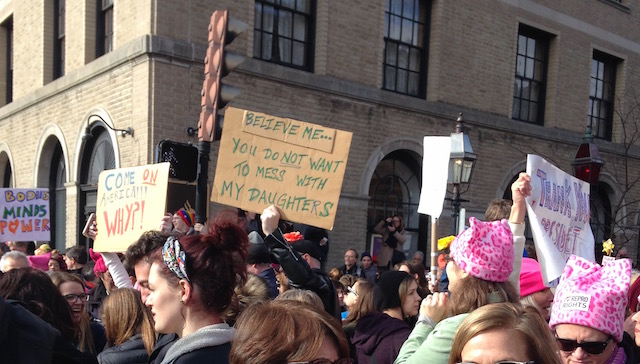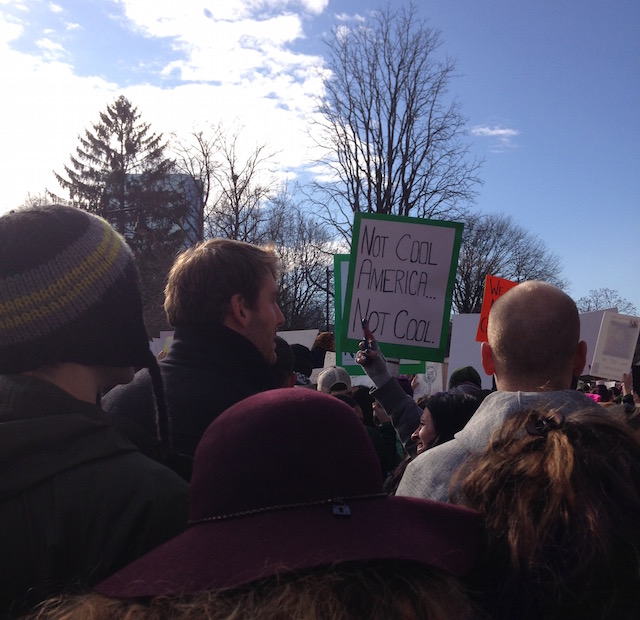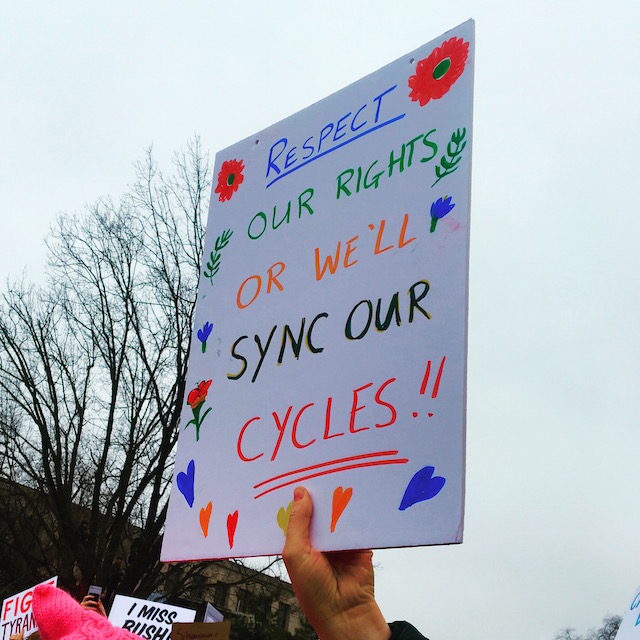TW Column by Martha Nichols
Protest Signs at Marches Make Words Count
TW celebrates boundary crossing with the Spring 2017 "Borders" issue—and this panel at AWP: "What Journalists Can Teach Literary Writers."
I sometimes forget that the most effective creative writing has nothing to do with schooling or publishing. Immersed as I am in the academic bubble of Cambridge, Massachusetts, I fall prey to ivy-covered biases, no matter how much I resist.
But then I’m joyously reminded all over again, as I was on January 21, 2017.
My husband, fifteen-year-old son, and I attended the Women’s March in Boston with up to 175,000 other people—more than twice the number predicted the day before. Actual crowd numbers are tough to pinpoint, but a good half million participated in the mother march in Washington, D.C., and Los Angeles drew up to 750,000 people. The march in New York City packed in an estimated quarter million. That’s just four cities—with 600-plus Women’s Marches around the world.
I was thrilled by the turnout, no question. When our sardine-packed subway car emerged on the bridge that overlooks the Charles River in Boston, a steady stream of people heading to the march flashed giddy thumbs up at us. We waved back. Boston is many things, but friendliness to strangers is not the norm.
What really struck me at this march, though, were the cleverly worded homemade signs. Participants also proudly waved professionally printed signs and banners, but the standouts were often scrawled in Magic Marker on scraps of cardboard—spontaneous expressions bubbling forth from the many knotty roots of this resistance. Their creative slogans had nothing to do with being “on message.”
You’ll find photos of just a few above and below, many snapped at the New York City and Boston Women’s Marches. Some of my favorites were all about the words. “Too Much for One Sign”—scratched on what looked like part of a pizza box—made me laugh out loud. I also appreciated the many women who’d written “Nasty Woman” on “Hello, I’m…” nametags, sticking them on their backs. I wish I’d thought to do something so simple, rather than assuming I didn’t have time to make a good sign.
Such grassroots creative writing matters more than ever in the current media landscape. In a world of fakery, it’s real. It twists canned political slogans in subversive ways. It’s angry. It's heartfelt. It’s a reflection of many causes and identities and every messy, scrappy, hard-to-reign-in impulse of a mass movement.
I’m far from alone in noting the protest signs, especially humorous ones. Snapshots have appeared all over digital news sites and social media feeds. If you click on the links to news articles at the end of this feature, you’ll find scores of other photos and videos. The weekly digital magazine Writers Resist, for instance, has published a “Women’s March Issue” with accounts by four writers as well as images and video.
While the latest protests against the Muslim travel ban have a more serious tone, creative expression is still on display. A friend recently forwarded a photo to me, uploaded via Reddit, of a group of women in hijab, one of them holding a handwritten sign in red and blue that reads: “2/3 of Trump’s wives were immigrants….proving once again we need immigrants to do jobs most Americans WOULDN’T DO.”
The AWP 2017 Conference in Washington, D.C., this week will likely spark more protests that make the connection between words and grassroots protest explicit, including a candlelight vigil for free speech after the conference ends. According to the Poetry Foundation's blog, an array of writers such as Gabrielle Bellot, Kazim Ali, Carolyn Forché, Ross Gay, and Luis J. Rodriguez will read at the vigil.
Last week, New York Times technology columnist Farhad Manjoo emphasized the impact of social media organizing by the “alt-majority.” As he notes:
Over two weekends, the protests have accomplished something just about unprecedented in the nearly two years since Mr. Trump first declared his White House run: They have nudged him from the media spotlight he depends on. They are the only force we’ve seen that has been capable of untangling his singular hold on the media ecosystem.
That's what I call making words count.
Thanks to all the anonymous writers who created the signs pictured here and elsewhere—and who continue to hold them high.





Art Information
- Photos provided courtesy of Martha Nichols; Holly Angell; Connie Van Rheenen; Leandra Ali-Dolsingh; and Patti, Nancy, and Steve Lewis; used with permission.
Publishing Information
- “Boston Rally Draws up to 175,000, Officials Say” by Evan Allen and other Globe staff, Boston Globe, January 21, 2017.
- “Crowd Scientists Say Women’s March in Washington Had 3 Times as Many People as Trump’s Inauguration” by Tim Wallace and Alicia Parlapiano, New York Times, January 22, 2017.
- “The Official Women’s March Attendance Numbers from Around the World Are In…” by Nathan Wellman, U.S. Uncut, January 21, 2017.
- “Women’s March Highlights as Huge Crowd Protests Trump: ‘We’re Not Going Away’” by Anemona Hartocollis, Yamiche Alcindor, and other NYT staff, New York Times, January 21, 2017.
- Photo of “2/3 of Trump’s Wives….”
- “The Women’s March Issue,” Writers Resist, February 2, 2017.
- "Writers Plan to Resist Trump at AWP and Writers Plan to Resist AWP" by Harriet staff, Harriet: A Poetry Blog (Poetry Foundation), January 31, 2017.
- “The Alt-Majority: How Social Networks Empowered Mass Protests Against Trump” by Farhad Manjoo, New York Times, January 30, 2017.
 Martha Nichols is Editor in Chief of Talking Writing. She's also a contributing editor at Women's Review of Books and a faculty instructor in the journalism program at the Harvard University Extension School. Her "First Person" column, about media and publishing trends, appears regularly in Talking Writing.
Martha Nichols is Editor in Chief of Talking Writing. She's also a contributing editor at Women's Review of Books and a faculty instructor in the journalism program at the Harvard University Extension School. Her "First Person" column, about media and publishing trends, appears regularly in Talking Writing.
Martha is the moderator for the AWP 2017 panel "What Journalists Can Teach Literary Writers"—and plans to attend the Candlelight Vigil for Free Speech this Saturday, February 11, near the White House. Come join her and her sign:

